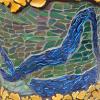Art Notes
Playing with Light

John Haley's painting "Phylum" is on display at the GMOA through Mar. 3.
Fine Lines: Noah Saunders, whose wire sculpture portraits are on display as part of the “Portrait Artists Show” in the Myers Gallery at Athens Academy, knew from a very young age that wire would be his medium for creating art. “In fifth grade, a guy who had made a reproduction of Alexander Calder's ‘Wire Circus’ came to our class and gave us a performance. He then passed out pipe cleaners to the class and showed us how to make little wire people… And I have been sculpting in wire ever since,” he recalls.
Seeking to create wire faces with as much detail and expression as you’d find in drawings or paintings, but with very few wire artists to learn from, Saunders began exploring graphic artists instead, particularly German Expressionists.
“This is a very faith-based process; I just trust that I know what I am doing. Then, I lay down the lines—attaching, weaving, wrapping it all together—and one day, suddenly, I am staring at a face!”

Basing his works on models in fashion magazines, supplemented by other art forms including Egyptian sculpture, Roman heads and graphic works, Saunders steadily constructs captivating characters such as the mohawk-sporting “Warrior” and “Midnight Visitor,” a folkloric-looking man with large antlers and a goatee.
“While each piece is true to the model, they do seem to take on parts of myself. So, if my mood is really strong, the face will begin to wear that mood as well. Also, I have the funny habit of overlaying the face of a person who has my fancy, which is still a crazy thing to suddenly discover. The pieces in this show are not true portraits in the traditional sense, but part portrait, part self-portrait and part exploration of the limits of wire. Each holding their own, I hope.”
Several of Saunders’ works are larger-than-life busts suspended from the ceiling, which allows their shadows to be seen on the blank walls behind them. As the pieces turn, revealing every angle and contour of the face in the reflection, viewers can catch multiple expressions and nuances.
“I have a special light where I work that allows me to always check the shadow at every step. There is a real connection to the graphic work that inspires me, so even though I am creating a [3D] sculpture, the shadow allows me to recreate the 2D graphic image that inspired me,” Saunders explains.
The “Portrait Artists Show,” on display through Dec. 12, additionally features works by John Ahee, Jean Westmacott, William “Rocky” Sapp, Meredith Lachin, Leah Mantini and Katherine Schuber. Athens Academy is located at 1281 Spartan Lane, and the Myers Gallery is open Monday through Friday, 8 a.m.–4 p.m.
Color Sensations: Spending the entirety of his artistic career at the forefronts of emerging art movements, John Haley progressed much too quickly through genres to ever be limited by or categorized into only one particular school. The Georgia Museum of Art’s newest exhibit, “John Haley: Berkeley School Abstract Expressionist,” provides pieces specifically from the '50s and '60s, showcasing his extreme sensitivity towards color and lighting, and a profound ability to express mood through seemingly random designs.
Upon graduating from the Minneapolis School of Art in 1927, where he was trained in a conventional style, Haley was awarded the Ethel Morrison Van Derlip scholarship, which enabled him to study for a year under German Modernist master Hans Hoffman in Munich. Hoffman’s cubist forms heavily influenced Haley’s style of painting, and by 1930 Haley was hired as an instructor at the University of California at Berkeley to support the study and practice of modern art.
Over the span of his 42-year career there, Haley played a crucial role in developing one of the strongest art departments in the country and founded two of the most significant art movements in California along the way: the 1930s Bay Area Watercolor School and the 1950s Berkeley School of Abstract Expressionism.
While much of his earlier work—water color and egg tempura paintings inspired by the landscapes and natural hues of California and the Southwest—fell into the “American Scene” movement and Regionalist style, Haley’s creations shifted into Abstract Expressionist oil paintings by the late '50s and '60s. Through the museum’s exhibit, an evolution in style can be observed as Haley transitions from geometric compositions of sharp, definitive lines and shapes to more loosely formed compositions that employ large brush strokes and swirled colors.
Haley was extremely well-rounded—experimenting in everything from printmaking, etching and photography to stained glass and mosaics—and the exhibit’s two small, bronze sculptures and two collages of ink blots and paper strips demonstrate how his distinct style was retained across media.
“John Haley: Berkeley School Abstract Expressionist” is on display through Mar. 3.
More by Jessica Smith
-

Art Around Town
A list of local art exhibits.
-

-

Art Around Town
A list of local art exhibits.









comments